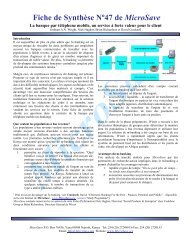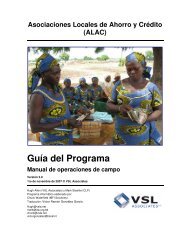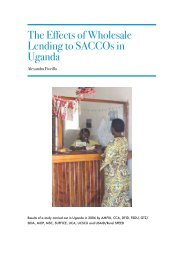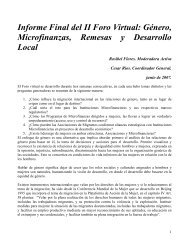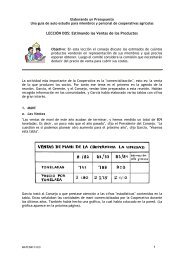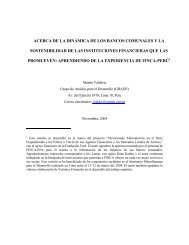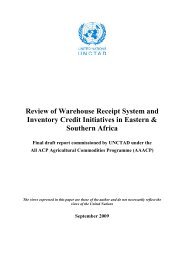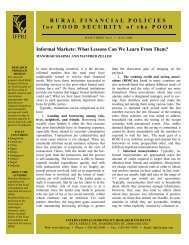Finance - Rural Finance Learning Center
Finance - Rural Finance Learning Center
Finance - Rural Finance Learning Center
Create successful ePaper yourself
Turn your PDF publications into a flip-book with our unique Google optimized e-Paper software.
<strong>Finance</strong> Study Guide Lesson 5<br />
For example, a client who has borrowed Ksh1,000 for petty trading for 12 months at<br />
15% interest on the declining balance must repay Ksh90 per month (made up of<br />
approximately Ksh83 principal and Ksh7 interest). If she misses the first three<br />
months of payments, the amount past due is Ksh270. The principal amount past<br />
due is Ksh249, yet the entire Ksh1,000 is at risk since there is a chance that she<br />
may not make any payments. According to the previous formula the percentage<br />
Amount Past Due would be 25% :<br />
Amount Past Due = Ksh249<br />
Ksh1,000<br />
= 25%<br />
Since no payments have been received, the true amount at risk is the full amount<br />
of the loan, Ksh1,000 (or 100%), not Ksh250.<br />
A more conservative formula to use to calculate risk is the Portfolio at Risk. The<br />
Portfolio at Risk formula considers the risk that the entire amount outstanding will<br />
not be repaid.<br />
Portfolio at Risk = outstanding balance of loans with payments past due 1<br />
current portfolio outstanding<br />
The Portfolio at Risk ratio helps to monitor default risk by comparing the<br />
outstanding portfolio to the balance of all loans which have one or more payments<br />
overdue. It is important to include the balance of all loans with a payment overdue<br />
and not just the amount overdue. This ratio reflects the true risk of a delinquency<br />
problem because it considers the full amount of the loan at risk even when the<br />
payments are small and the loan terms are long. If a portfolio is growing rapidly,<br />
using the Amount Past Due Ratio may understate the risk as the outstanding<br />
portfolio (denominator) is growing at a faster rate than the amounts becoming due<br />
(since the outstanding portfolio grows with the total disbursed amount whereas the<br />
amount due only grows with the payments as they become due). Therefore the<br />
potential risk may not be known for some time.<br />
Using the example above, if a client borrows Ksh1,000 and makes the first two<br />
monthly payments and then misses the next three months, the principal past due is<br />
Ksh249 (Ksh83 per month). The principal still outstanding is Ksh1,000 less 2 months<br />
of payments (principal portion is Ksh166; principal plus interest equals Ksh180).<br />
This results in Ksh834 still outstanding. The Portfolio at Risk is therefore 100% for<br />
this loan:<br />
Portfolio at Risk = 834<br />
834<br />
= 100%<br />
The Portfolio at Risk ratio is affected by the organization's write-off policy<br />
(discussed below). Continuing to maintain loans on the books rather than write<br />
them off once it has been determined that they are unlikely to be repaid overstates<br />
the size of the portfolio.<br />
1 If interest is included in the amount of the loan when it is recorded as an asset, it should be included in the<br />
outstanding balance in the calculation of Portfolio at Risk.<br />
Calmeadow 4




